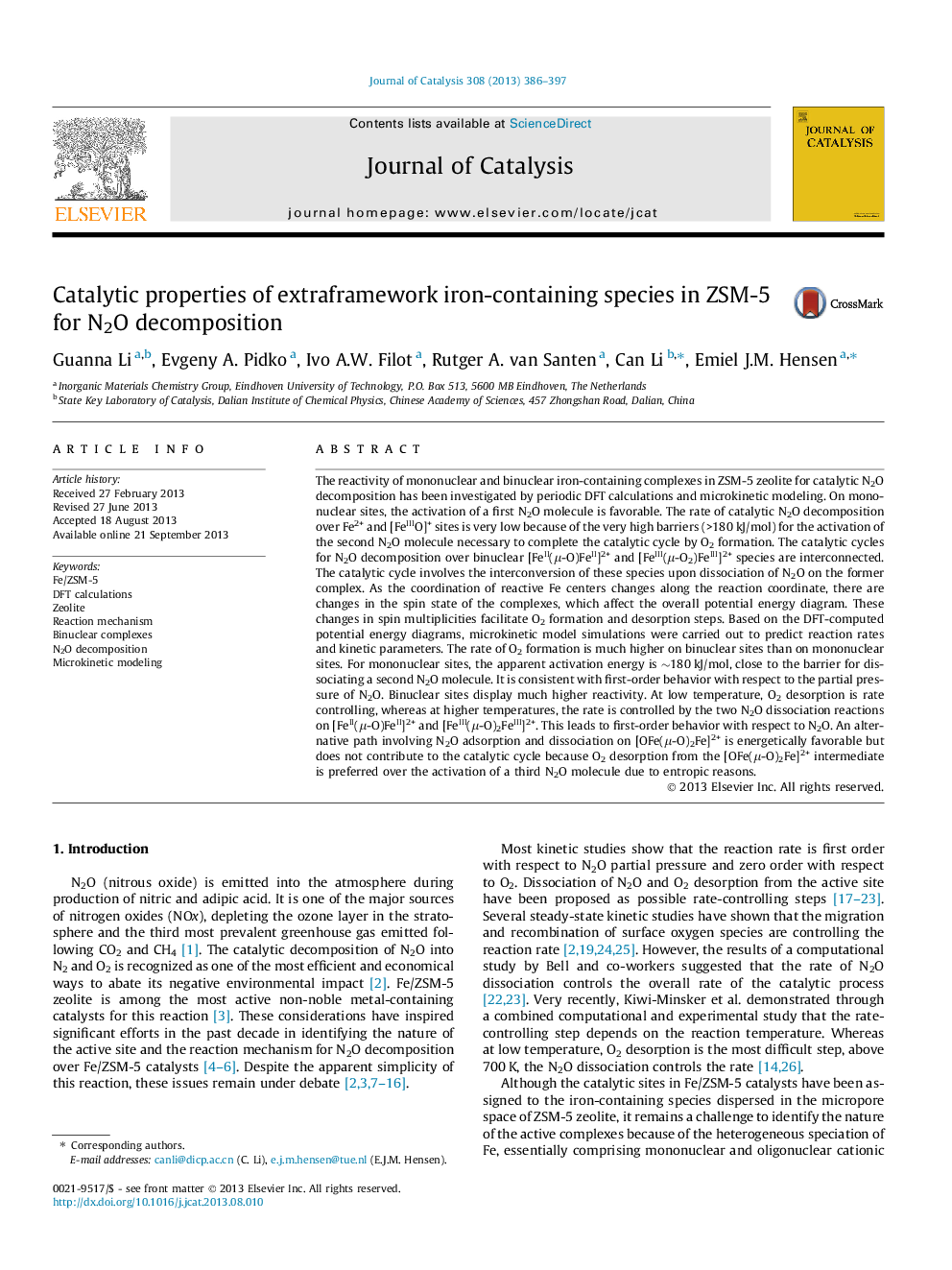| کد مقاله | کد نشریه | سال انتشار | مقاله انگلیسی | نسخه تمام متن |
|---|---|---|---|---|
| 61214 | 47569 | 2013 | 12 صفحه PDF | دانلود رایگان |

• Fe2+, [FeO]+, [Fe(μ-O)Fe]2+, and [Fe(μ-O)2Fe]2+ in ZSM-5 studied for N2O decomposition.
• Fe2+ & [FeO]+: facile activation of first N2O, second N2O decomposition difficult.
• Fe(μ-O)Fe2+: facile activation of two N2O molecules, formation of [OFe(μ-O2)Fe]2+, desorption O2 easy.
• Rate of O2 formation over binuclear sites much higher than over mononuclear sites.
• Shift in rate-controlling step for binuclear sites with increasing temperature: from O2 desorption to N2O decomposition.
The reactivity of mononuclear and binuclear iron-containing complexes in ZSM-5 zeolite for catalytic N2O decomposition has been investigated by periodic DFT calculations and microkinetic modeling. On mononuclear sites, the activation of a first N2O molecule is favorable. The rate of catalytic N2O decomposition over Fe2+ and [FeIIIO]+ sites is very low because of the very high barriers (>180 kJ/mol) for the activation of the second N2O molecule necessary to complete the catalytic cycle by O2 formation. The catalytic cycles for N2O decomposition over binuclear [FeII(μ-O)FeII]2+ and [FeIII(μ-O2)FeIII]2+ species are interconnected. The catalytic cycle involves the interconversion of these species upon dissociation of N2O on the former complex. As the coordination of reactive Fe centers changes along the reaction coordinate, there are changes in the spin state of the complexes, which affect the overall potential energy diagram. These changes in spin multiplicities facilitate O2 formation and desorption steps. Based on the DFT-computed potential energy diagrams, microkinetic model simulations were carried out to predict reaction rates and kinetic parameters. The rate of O2 formation is much higher on binuclear sites than on mononuclear sites. For mononuclear sites, the apparent activation energy is ∼180 kJ/mol, close to the barrier for dissociating a second N2O molecule. It is consistent with first-order behavior with respect to the partial pressure of N2O. Binuclear sites display much higher reactivity. At low temperature, O2 desorption is rate controlling, whereas at higher temperatures, the rate is controlled by the two N2O dissociation reactions on [FeII(μ-O)FeII]2+ and [FeIII(μ-O)2FeIII]2+. This leads to first-order behavior with respect to N2O. An alternative path involving N2O adsorption and dissociation on [OFe(μ-O)2Fe]2+ is energetically favorable but does not contribute to the catalytic cycle because O2 desorption from the [OFe(μ-O)2Fe]2+ intermediate is preferred over the activation of a third N2O molecule due to entropic reasons.
Catalytic decomposition of N2O over mononuclear and binuclear iron-containing complexes in ZSM-5 zeolite has been studied by periodic DFT calculations and microkinetic modeling. The rate of O2 formation is much higher on binuclear sites than on mononuclear sites. The catalytic cycle for N2O decomposition over binuclear sites proceeds through a [Fe(μ-O2)Fe]2+ intermediate.Figure optionsDownload high-quality image (69 K)Download as PowerPoint slide
Journal: Journal of Catalysis - Volume 308, December 2013, Pages 386–397